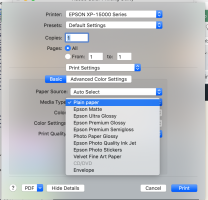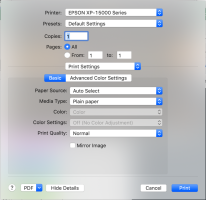mavtop
Getting Fingers Dirty
- Joined
- Nov 14, 2021
- Messages
- 60
- Reaction score
- 14
- Points
- 40
- Printer Model
- Epson XP 15000
Hi all, this is my first post here, i read several guides on the paper profiling, found here like
https://www.printerknowledge.com/th...roduce-excellent-printer-profiles.6878/page-1
but i have some questions to make.
I have an Epson XP 15000 and inside i found only the Epson profiles for Epson Paper, i have some of them but i have also some Canon and other brands paper, so i would like to make profiles for them and if i can make more accurate profiles also for Epson paper.
So a friend will give me the EFI ES 1000 but with no software and no ruler, just the spectophotometer and the usb cable.
I know that it is an old device but i suppose it will work with ArgyllCMS to profile my paper/printer combinations.
Now my questions:
- Can i create a ruler for it easily ? can i use grey cardboard for it ? or do i need to use white cardboard ?
- Can i use the EFI ES 1000 to profile my new Imac 2019 5k retina display too always with ArgyllCMS ? i read that new monitor are not calibrated from old devices, is it true ?
- When i will print the charts would i use some specific software ? like ACPU ? or what ?
- Which settings for the printer and for the paper i will have to use when printing charts ? i have glossy, semigloss and matte paper, but while the first two are Epson the third is another brand so what i have to choose ? i have another paper that is labelled Photo Paper only so what i have to choose for it ?
- When i create the target charts, which size for the chart i have to choose ? i mean dimension of the single pattern, because i read that if it is too small i can have read errors ? but i can have more patterns with smaller dimensions ? which device have i to specify for the pattern ?
- is it better making a charts with less pattern and then re-run argyl to use it again (so 2 runs) or better make a bigger chart (1 run only) ? How many grey i have to use, some use 32/64/128/256, whites and blacks ? are there some standards values ?
- i have found some charts from some users here (tiff files) but i don't understand if i can use them with my printer/device to read directly or is better create them from scratch.
- is there a specific way to read the patterns (i mean speed of moving of the spectophotometer and so on) ?
- last question for now, do you think i can make better profiles for the Epson paper that i have versus the original Epson profiles with my EFI ES 1000 ?
thanks for all the helps
mavtop
https://www.printerknowledge.com/th...roduce-excellent-printer-profiles.6878/page-1
but i have some questions to make.
I have an Epson XP 15000 and inside i found only the Epson profiles for Epson Paper, i have some of them but i have also some Canon and other brands paper, so i would like to make profiles for them and if i can make more accurate profiles also for Epson paper.
So a friend will give me the EFI ES 1000 but with no software and no ruler, just the spectophotometer and the usb cable.
I know that it is an old device but i suppose it will work with ArgyllCMS to profile my paper/printer combinations.
Now my questions:
- Can i create a ruler for it easily ? can i use grey cardboard for it ? or do i need to use white cardboard ?
- Can i use the EFI ES 1000 to profile my new Imac 2019 5k retina display too always with ArgyllCMS ? i read that new monitor are not calibrated from old devices, is it true ?
- When i will print the charts would i use some specific software ? like ACPU ? or what ?
- Which settings for the printer and for the paper i will have to use when printing charts ? i have glossy, semigloss and matte paper, but while the first two are Epson the third is another brand so what i have to choose ? i have another paper that is labelled Photo Paper only so what i have to choose for it ?
- When i create the target charts, which size for the chart i have to choose ? i mean dimension of the single pattern, because i read that if it is too small i can have read errors ? but i can have more patterns with smaller dimensions ? which device have i to specify for the pattern ?
- is it better making a charts with less pattern and then re-run argyl to use it again (so 2 runs) or better make a bigger chart (1 run only) ? How many grey i have to use, some use 32/64/128/256, whites and blacks ? are there some standards values ?
- i have found some charts from some users here (tiff files) but i don't understand if i can use them with my printer/device to read directly or is better create them from scratch.
- is there a specific way to read the patterns (i mean speed of moving of the spectophotometer and so on) ?
- last question for now, do you think i can make better profiles for the Epson paper that i have versus the original Epson profiles with my EFI ES 1000 ?
thanks for all the helps
mavtop


